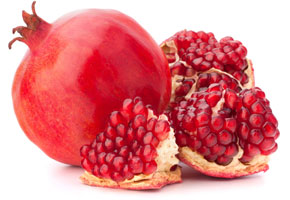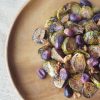
Eating with the season: Pomegranates
By Linda Bonvie | 1 Comment | Posted 10/26/2014
It’s a sure sign that fall has arrived. As colorful as autumn foliage, the appearance of this wonderful round fruit is one of the most joyous aspects of the harvest season.
And it’s a healthy one as well. High in antioxidants and fiber, it’s must-have in your diet.
And no, this isn’t an ode to the pumpkin, but rather to the pomegranate!
Now perhaps you’re only familiar with pomegranate juice, in which case you’re missing out on the benefits of the whole fruit. The trick is to know the “secret” of getting inside one to find the beautiful red, juicy seeds without squishing the juice out of them.
Pomegranates also have some cool history behind them. Even its name, “pomme garnete,” which translates to “seeded apple” goes back many centuries. And the symbolism behind it shows how many cultures have held the pomegranate in high esteem.
In Japan, it’s considered to be a symbol of fertility and prosperity. Ancient Greeks referred to it as the symbol of love. Shakespeare even made use of that symbolism by having a pomegranate tree appear outside of Juliet’s window in “Romeo and Juliet.”
But there’s a good reason why the pomegranate holds such a prominent role in folklore: it is truly a “superfood.”
The main benefits come from some complex antioxidant compounds that make it just about the healthiest fruit out there. It also contains a whopping amount of vitamin C. One humble pomegranate will give you almost half of your daily C requirement.
In a study of antioxidant levels found in different juices, pomegranates scored top place, beating out grape, acai and even blueberry juice. And studies in Israel found that they can help your joints and reduce arthritis pain – mainly due to their amazing anti-inflammatory properties.
Okay, now that you know how great pomegranates are, how do you get more of these amazing fruits into your diet?
Juice is one way, and there are plenty of choices in the store (only be sure to get pure pomegranate juice, and not one diluted or with added sweeteners).
But if you want all the benefits of the pomegranate in as fresh a form as possible, you want the whole fruit.
The beautiful red “jewels” inside are called arils. It’s sort of like a juice sack that covers a small seed. The seeds are edible too (I love them, but if you don’t you can just spit them out).
Of course, what probably discourages most people from buying fresh pomegranates is the tough red rind and white membrane between the arils, which are quite bitter and should be tossed out after you open one. Here’s what the Pomegranate Council recommends:
- Cut off the crown, and cut the pomegranate into sections.
- Place the sections in a bowl of water, then roll out the arils with your fingers. Discard everything else.
- Strain out the water, then eat the arils whole, seeds and all.
While that works, I sometimes use an alternate method of just scoring the fruit in quarters, wiggling the sections apart and then working the seed clusters out.
The key to getting at the seeds efficiently is to try and remove as much of the bitter white membrane as possible in large pieces, rather than picking it out.
But once you learn to do it the right way, it’s really not that hard! You might even find yourself wearing a button that says, “Powered by Pomegranates.”


 Contact us
Contact us




























One Response to Eating with the season: Pomegranates